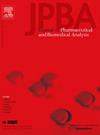Distinct cellular uptake patterns of two anticancer unsymmetrical bisacridines and their metabolic transformation in tumor cells
IF 3.1
3区 医学
Q2 CHEMISTRY, ANALYTICAL
Journal of pharmaceutical and biomedical analysis
Pub Date : 2024-09-30
DOI:10.1016/j.jpba.2024.116493
引用次数: 0
Abstract
Unsymmetrical bisacridines (UAs) represent a novel class of anticancer agents. Their high cytotoxicity towards multiple human cancer cell lines and inhibition of human tumor xenograft growth in nude mice signal their potential for cancer treatment. Therefore, the mechanism of their strong biological activity is broadly investigated. Here, we explore the efflux and metabolism of UAs, as both strongly contribute to the development of drug resistance in cancer cells. We tested two highly cytotoxic UAs, C-2028 and C-2045, as well as their glucuronic acid and glutathione conjugates in human cancer cell lines (HepG2 and LS174T). As a point of reference for cell-based systems, we examined the rate of UA metabolic conversion in cell-free systems. A multiple reaction monitoring (MRM)-mass spectrometry (MS) method was developed in the present study for analysis of UAs and their metabolic conversion in complex biological matrices. Individual analytes were identified by several features: their retention time, mass-to-charge ratio and unique fragmentation pattern. The rate of UA uptake and metabolic transformation was monitored for 24 h in cell extracts and cell culture medium. Both UAs were rapidly internalized by cells. However, C-2028 was gradually accumulated, while C-2045 was eventually released from cells during treatment. UAs demonstrated limited metabolic conversion in cells. The glucuronic acid conjugate was excreted, whereas the glutathione conjugate was deposited in cancer cells. Our results obtained from cell-free and cell-based systems, using a uniform MRM-MS method, will provide valuable insight into the mechanism of UA biological activity in diverse biological models.
两种抗癌不对称双吖啶的不同细胞摄取模式及其在肿瘤细胞中的代谢转化。
不对称双吖啶(UAs)是一类新型抗癌剂。它们对多种人类癌细胞株具有很高的细胞毒性,并能抑制人类肿瘤异种移植在裸鼠体内的生长,这表明它们具有治疗癌症的潜力。因此,人们对其强大生物活性的机制进行了广泛的研究。在此,我们探讨了 UAs 的外流和代谢问题,因为这两个问题在很大程度上导致了癌细胞耐药性的产生。我们在人类癌细胞系(HepG2 和 LS174T)中测试了两种高细胞毒性 UAs(C-2028 和 C-2045)及其葡萄糖醛酸和谷胱甘肽共轭物。作为基于细胞的系统的参考点,我们研究了无细胞系统中 UA 的代谢转化率。本研究开发了一种多反应监测(MRM)-质谱(MS)方法,用于分析复杂生物基质中的UA及其代谢转化。通过保留时间、质量电荷比和独特的碎片模式等几个特征来识别单个分析物。在细胞提取物和细胞培养基中对 UA 的吸收率和代谢转化率进行了 24 小时的监测。两种 UA 都能迅速被细胞内化。然而,C-2028 会逐渐积累,而 C-2045 最终会在处理过程中从细胞中释放出来。UAs 在细胞中的代谢转化有限。葡萄糖醛酸共轭物被排出体外,而谷胱甘肽共轭物则沉积在癌细胞中。我们采用统一的 MRM-MS 方法从无细胞和基于细胞的系统中获得的结果将为我们深入了解 UA 在不同生物模型中的生物活性机制提供宝贵的信息。
本文章由计算机程序翻译,如有差异,请以英文原文为准。
求助全文
约1分钟内获得全文
求助全文
来源期刊
CiteScore
6.70
自引率
5.90%
发文量
588
审稿时长
37 days
期刊介绍:
This journal is an international medium directed towards the needs of academic, clinical, government and industrial analysis by publishing original research reports and critical reviews on pharmaceutical and biomedical analysis. It covers the interdisciplinary aspects of analysis in the pharmaceutical, biomedical and clinical sciences, including developments in analytical methodology, instrumentation, computation and interpretation. Submissions on novel applications focusing on drug purity and stability studies, pharmacokinetics, therapeutic monitoring, metabolic profiling; drug-related aspects of analytical biochemistry and forensic toxicology; quality assurance in the pharmaceutical industry are also welcome.
Studies from areas of well established and poorly selective methods, such as UV-VIS spectrophotometry (including derivative and multi-wavelength measurements), basic electroanalytical (potentiometric, polarographic and voltammetric) methods, fluorimetry, flow-injection analysis, etc. are accepted for publication in exceptional cases only, if a unique and substantial advantage over presently known systems is demonstrated. The same applies to the assay of simple drug formulations by any kind of methods and the determination of drugs in biological samples based merely on spiked samples. Drug purity/stability studies should contain information on the structure elucidation of the impurities/degradants.

 求助内容:
求助内容: 应助结果提醒方式:
应助结果提醒方式:


